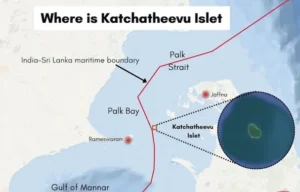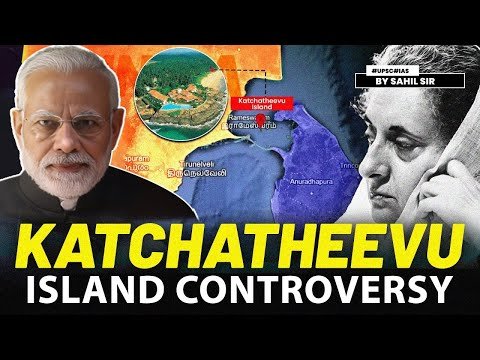Kachchatheevu Island Dispute: Causes and Solutions | UPSC
- Context: The encroachment by Tamil Nadu fishermen in Sri Lankan waters in search of profitable catch and their detention by the Sri Lankan Navy have often caused friction in Indo-Sri Lankan ties.
- In order to maintain amiable bilateral relations, concurrent with India’s “Neighbourhood First” policy, resolving this fishing dispute has assumed greater significance.
- The government of Tamil Nadu alleges that the Indo-Sri Lankan fishing dispute is a direct consequence of the “unlawful” ceding of Kachchatheevu to Sri Lanka.
Analysis
Where is Kachchatheevu located?
- Katchatheevu, in the Palk Strait, is a tiny island, measuring 285.20 acres, and is located about 14 nautical miles from Rameswaram in India.
- The proximity of the isle to both countries, India and Sri Lanka, has been the cause of its being a bone of contention between the two nations for decades now.

Why did India give away Kachchatheevu to Sri Lanka?
- Treaties were signed between Sri Lanka and India in 1974 and 1976, to demarcate the maritime boundary — the International Maritime Boundary Line (IMBL).
- Under these agreements, India recognized Sri Lanka’s sovereignty over Kachchatheevu whilst gaining sovereignty over Wadge Bank in return.
- This decision was undertaken in order to cement friendly relations between the two countries and prevent ties from souring in the future over the relatively minor matter of the small uninhabited island.
- Described by Indira Gandhi as a “sheer rock with no strategic significance”, she could not have foreseen the animosity this uninhabited island would generate amongst Tamils from both sides of the border which continues to haunt India-Sri Lanka relations today.
India gets Wadge Bank
- On the day of signing the second agreement in March 1976, India and Sri Lanka inked another understanding regarding ownership of Wadge Bank, a 10,000-square-kilometres’ undersea plateau situated nearly 50 kilometres south of Kanyakumari in Tamil Nadu. Through this understanding, Sri Lanka recognised India’s sovereignty over Wadge Bank and its rich marine resources.
- At the time of signing the agreement, Wadge Bank fell under India’s exclusive economic zone but outside its territorial waters. Traditionally, fishermen from both India and Sri Lanka carried out fishing in this area. As part of the agreement, a certain number of licensed fishers from Sri Lanka were allowed in Wadge Bank for three years.
Can India retrieve Kachchatheevu Island?
- Both countries have notified the two agreements signed in 1974 and 1976 under the UN Convention on the Law of the Seas (UNCLOS) – an international agreement that provides the legal framework for all marine and maritime activities.
-
- The agreement noted Article 15 of the UNCLOS which exempted the use of median line to determine the IMBL (International Maritime Boundary Line), and recognised the adjustments agreed to it by the contracting nations. Due to this, the Katchatheevu island fell on the Sri Lankan side of the IMBL.
-
- In addition to that, the agreements entered into by India and Sri Lanka are binding under the Vienna Convention on the Law of Treaties, 1969 (VCLT). There are no provisions in both the Agreements that address either withdrawal or termination.
-
-
- India cannot unilaterally revoke the agreement and to withdraw India needs to notify Sri Lanka and acquire its consent. Sri Lanka had staunchly opposed any change to the status quo on the maritime boundary with India.
-
Why do Indians cross the Maritime boundary?
- Bottom-trawling by Indian fishermen has contributed to the destruction of their primary source of livelihood by depleting the fisheries in Indian waters.
- These bottom trawlers not only destroy the seabed and marine ecosystem but tear the fishing nets and destroy the traditional boats of the Sri Lankan Tamils.
- Between 1983 and 2009, Indian fishermen had easier access to the rich Sri Lankan waters as the maritime boundary in the Palk Strait was not heavily guarded.
- Since 2009, the Sri Lankan navy has tightened surveillance of its northern maritime boundary to halt a potential return of Tamil insurgents.
-
-
- This, in turn, has had the secondary effect of increasing the number of arrests of Indian fishermen.
- Earlier the Sri Lankan navy used to release the boats that were confiscated when the fishermen were set free. But, now they release only the fishermen and the boats are kept with the navy.
-
What could be the possible solutions to Kachchatheevu dispute?
a) Discouraging unsustainable fishing
- An unsustainable fishing practice known as bottom trawling, which tows a net along the ocean floor to catch fish and other marine species — commonly practiced by Indian fishers — has come in the way of efforts to resolve the dispute between the two countries.
- Experts say that in addition to netting the targeted fish species and shrimps, this method pulls in a variety of marine life, including coral and seaweed. This method has been blamed for the depletion of marine resources in large parts of Palk Bay, especially on the Indian side.
- In past negotiations, Sri Lankan authorities have agreed to “consider letting Indian fishers into their waters if, and only if, the latter gave up bottom-trawling.
- The way forward is if New Delhi and Tamil Nadu are determined, they can create a win-win scenario in Palk Bay. The immediate decommissioning of trawlers is an important prerequisite for this unconventional solution.
- Other suggestions may include permitting a limited number of Indian and Sri Lankan fishers into each other’s waters up to a certain distance from the IMBL and the promotion of deep-sea fishing among Indian fishermen.
b) Palk Bay Scheme
- In order to prevent Tamil Nadu fishermen from crossing the IMBL, the Centre had announced a ₹1,600 crore ‘Palk Bay Scheme’, under which around 2,000 trawlers were to be replaced with deep sea fishing vessels.
- Of the unit cost of each vessel (₹80 lakh), 50% would be borne by the Centre, 20% by the State government and 10% by the beneficiary, and the remaining 20% would be met through institutional financing.
- More importantly, the Centre feels that deep sea fishing is the “only solution” to promote ecologically sustainable fishing and reduce “fishing pressure” around the close proximity of the IMBL and the incidents of cross-border fishing.
- The Union government framed this scheme exclusively for Tamil Nadu, as the fishermen of the Palk Bay districts were invariably caught by the Sri Lankan authorities for crossing the International Maritime Boundary Line illegally.
- However, the scheme has failed to take off, despite the passage of over six years. Lack of interest among beneficiaries to make the transition, the “unaffordable cost” of the boats for deep sea fishing, the higher operational cost per voyage and the unwillingness of banks to lend are among the reasons cited. The Union and the Tamil Nadu government need to take steps to implement the scheme with full vigour.
Conclusion
- The reinstatement of the “traditional rights” of Tamil fishermen which Tamil Nadu continues to call for is short-sighted. It only serves as political rhetoric helping political parties curry favour amongst a one million strong vote base. As a responsible power, India has an obligation to abide by international law.
- The bilateral relation with Sri Lanka should take precedence over the small matter of an uninhabited island which fails to provide a feasible solution to the fishing dispute. Over the years, relations with Sri Lanka have been amicable at best. Colombo’s growing closeness to China means New Delhi has to tread with caution.
- The need of the hour is to incentivize fishermen towards a sustainable alternative to bottom-trawling which will safeguard the future of both the Indian and Sri Lankan fishermen without compromising Indo-Sri Lankan ties.
- The willful and inadvertent transgressions into Sri Lankan waters by Indian fishermen need to be curtailed, but this will only be feasible when the livelihoods of these fishermen are secured—the duty and obligation of which rests with the Tamil Nadu and Central governments.
References:
- https://maritimeindia.org/retrieving-kachchatheevu-for-india-a-non-starter/
- https://thefederal.com/states/south/tamil-nadu/why-tn-fishermen-continue-to-fish-in-forbidden-waters/
- https://www.indiatoday.in/india/story/katchatheevu-island-row-pm-modi-india-sri-lanka-fishing-rights-fishermen-issue-2521882-2024-04-01
- https://www.thehindu.com/news/national/katchatheevu-what-is-the-controversy-all-about/article68015993.ece
- https://www.thehindu.com/news/national/tamil-nadu/katchatheevu-an-island-for-all-or-none/article66606862.ece
- https://www.telegraphindia.com/india/katchatheevu-controversy-gulf-between-claims-on-island/cid/2010527
- https://www.thehindu.com/news/national/tamil-nadu/explained-the-katchatheevu-controversy/article67213802.ece
Mains Answer Writing Practice GS Paper 2
Topic: International Relations
- Analyse the historical, geopolitical, and legal factors contributing to the Kachchatheevu Island dispute, and the potential implications and solutions exist for resolving this territorial disagreement between India and Sri Lanka. (Answer in 250 words)

